Combination of Resistors-
Before you go through this article, make sure that you have gone through the previous article on Series Combination of Resistors.
Sometimes, a number of resistors are connected in a circuit in order to get a desired value of current in the circuit.
Resistors may be combined in a circuit in the following ways-
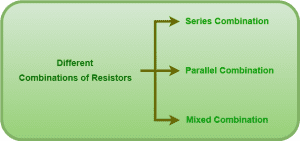
- Series Combination
- Parallel Combination
- Mixed Combination
In this article, we will learn about parallel combination of resistors.
Parallel Combination of Resistors-
|
Two or more resistors are said to be connected in parallel combination when-
|
Expression For Equivalent Resistance-
Consider-
- Two resistors of resistances R1 and R2 are connected in parallel combination across a battery.
- The battery maintains a potential difference V across the combination.
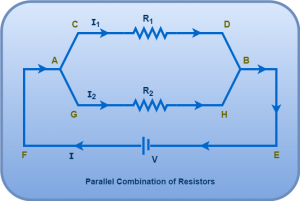
Using Kirchoff’s Voltage Law in the loop ACDBEFA, we have-
-I1R1 + V = 0
V = I1R1
I1 = V / R1 ………..(1)
Using Kirchoff’s Voltage Law in the loop AGHBEFA, we have-
-I2R2 + V = 0
V = I2R2
I2 = V / R2 ………..(2)
Also Read- How to Apply Kirchhoff’s Laws?
Adding Equations-01 & 02, we get-

(Equation-03)
Now, we wish to replace the above parallel combination of resistors with a single equivalent resistor of resistance Req.
| An equivalent resistor is one which draws the same current from the battery as drawn by the individual resistors together. |
Replacing the above parallel combination of resistors with an equivalent resistor, we have-
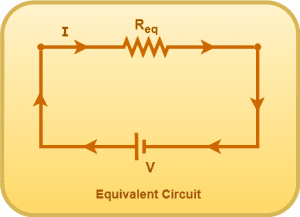
Using Kirchoff’s Voltage Law in the above circuit, we have-
-IReq + V = 0
V = IReq
I = V / Req ………..(4)
On comparing equations (3) and (4), we get-
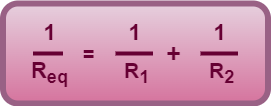
This is the required expression for equivalent resistance of a parallel combination of two resistors.
The formula can be extended for n resistors in the same way.
|
In parallel combination,
the reciprocal of equivalent resistance is equal to the sum of reciprocals of the individual resistances. |
Important Notes-
Note-01:
In parallel combination,
- The potential difference across each resistor is same but current divides among the individual resistors.
- The total current drawn from the battery is equal to the sum of currents flowing through the individual resistors.
Note-02:
If two resistors having resistances R1 and R2 are combined in parallel combination, then their equivalent resistance is given by-

(Not Recommended to Use)
Taking LCM and then reciprocal, this formula for two resistors can be rewritten as-
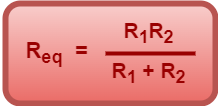
(Recommended to Use)
Trick To LearnEquivalent Resistance = Product of two resistors / Sum of two resistors |
If the resistance of one resistor is n times the resistance of the other resistor i.e. R2 = nR1 (say), then substituting in the above formula and solving, the formula can be rewritten as-
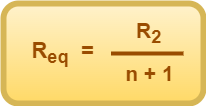
(Recommended to Use)
Trick To LearnEquivalent Resistance = Big One / (n+1) |
Note-03:
If n resistors each of resistance R are combined in parallel combination, then their equivalent resistance is given by-
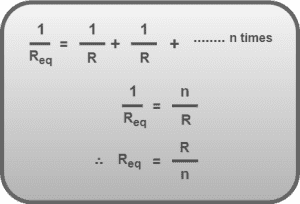
Note-04:
In parallel combination, the equivalent resistance is smaller than the smallest individual resistance.
Note-05:
The smallest value of equivalent resistance that can be obtained with the given resistances is by combining them in parallel combination.
Test Your Concepts-
Quiz on Parallel Combination of Resistors
Next Article-
Get more notes & other study material of the Chapter Current Electricity.

